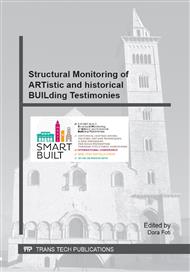p.193
p.198
p.204
p.212
p.218
p.225
p.231
p.237
p.243
A Wireless Sensor Network Innovative Architecture for Ambient Vibrations Structural Monitoring
Abstract:
Wireless sensor networks can be beneficial for monitoring ambient vibrations in historical buildings where the installation of traditionally wired system may be either difficult due to wiring difficulties or forbidden due to prohibitive legislation. In this paper, a novel wireless sensor network architecture is presented that is focusing on efficiently monitoring ambient vibrations in historical buildings. Traditional wired monitoring technologies are often difficult to be installed in historical buildings either to high costs for installing the wires or to prohibitive legislations. Employing a wireless system could be beneficial. However, as there is no wireless system of high resolution available in the market, an innovative network architecture is proposed that efficiently combines the benefits of both the wired and wireless systems. The problem of synchronization that this novel architecture introduces, is also discussed in this paper along with a possible solution.
Info:
Periodical:
Pages:
218-224
Citation:
Online since:
August 2014
Keywords:
Price:
Сopyright:
© 2015 Trans Tech Publications Ltd. All Rights Reserved
Share:
Citation:



